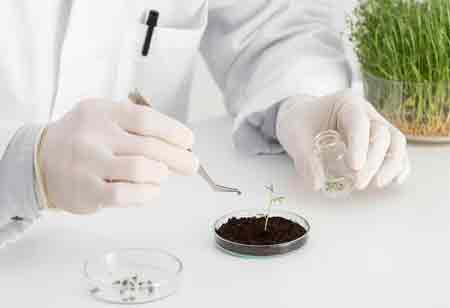Thank you for Subscribing to Agri Business Review Weekly Brief
Circular Nutrients, Resilient Farms: The Organic Phosphate Revolution
Phosphorus management is shifting from direct application to enhancing soil biology, unlocking nutrient reserves through practices that foster microbial activity and sustainable ecosystem health.

By
Agri Business Review | Friday, December 05, 2025
Stay ahead of the industry with exclusive feature stories on the top companies, expert insights and the latest news delivered straight to your inbox. Subscribe today.
Phosphorus is a uniquely vital element, serving as the cellular energy currency of life, the structural backbone of DNA, and an indispensable driver of plant growth, reproduction, and agricultural productivity. For decades, the approach to ensuring crops have enough of this vital nutrient has been direct and chemical: mine phosphate rock, process it into a highly soluble form, and apply it to the soil. This model, which is based on the principle of feeding the plant directly, is now being thoroughly re-examined. A new paradigm is emerging, one that shifts the focus from feeding the plant to empowering the soil's intricate ecosystem to deliver nutrients as nature intended. This is the regenerative approach to phosphorus, a journey from inert rock to a thriving root system, powered by biology.
The Conventional Input Model
The standard agricultural method of phosphorus delivery relies on the industrial extraction of finite rock phosphate reserves. The goal of this process is to break down the stable mineral structure of the rock and convert the phosphorus into a water-soluble ionic form, primarily in the form of orthophosphate ions.
Supplying a concentrated, readily available dose of phosphorus ensures young seedlings receive vital nutrients at the critical stage of establishment. However, the efficiency of this delivery system is a point of growing concern. Once applied to the soil, these highly reactive soluble phosphate ions are prone to quickly binding with other elements. In acidic soils, they react with iron and aluminum to form insoluble compounds. In alkaline soils, they bind with calcium, creating equally unavailable mineral forms. This process, known as phosphorus fixation or "lock-up," can render a substantial portion of the applied fertilizer unavailable to the crop it was intended to nourish within weeks or even days. The system operates on overwhelming the soil's natural chemistry, hoping the plant can absorb what it needs before the rest is immobilized.
The Regenerative Philosophy: Awakening the Soil Bank
The regenerative approach acknowledges that the vast majority of agricultural soils are not actually deficient in total phosphorus. In fact, many soils that have received decades of conventional fertilization contain enormous reserves of the nutrient. The issue is not an absence of phosphorus, but a lack of plant-available phosphorus. It is locked away in mineral compounds and complex organic matter—a vast but inaccessible reservoir of nutrients.
The regenerative philosophy posits that, instead of adding more soluble inputs to an already rich but locked system, the goal should be to create the biological conditions necessary to unlock the existing ban of nutrients. It is a shift from chemistry to biology, from intervention to facilitation. The strategy revolves around cultivating a growing soil microbiome, a bustling subterranean community of fungi, bacteria, and other organisms that have spent eons evolving sophisticated mechanisms to cycle nutrients. In this model, the farmer becomes less of a chemical supplier and more of a habitat manager, fostering the microscopic workforce that will deliver phosphorus to the plant roots on demand.
Mycorrhizal fungi and phosphate-solubilizing microbes play a central role in enhancing plant nutrition by unlocking inaccessible forms of phosphorus in the soil. Mycorrhizal fungi form symbiotic associations with over 90% of plant species, extending their thread-like hyphae far beyond the root zone to access nutrient pools unavailable to roots alone. Through the secretion of mild organic acids such as oxalic and citric acid, these fungi dissolve mineral-bound phosphorus and transport it directly to plants, which in return provide them with carbon-rich sugars produced during photosynthesis—creating a finely balanced biological marketplace.
Complementing this process, phosphate-solubilizing microorganisms (PSMs) contribute by releasing organic acids that free phosphate bound to mineral cations and by producing enzymes, such as phosphatases, that convert complex organic phosphorus into plant-available forms. Plants actively support these beneficial microbes by exuding compounds from their roots to attract and sustain them within the rhizosphere.
Practices for a Living Phosphorus Cycle
Activating the natural phosphorus cycle requires more than the application of a single input—it demands a systems-based approach that restores soil life and function. Central to this is minimizing soil disturbance. Conventional tillage practices, such as plowing and discing, disrupt the intricate hyphal networks of mycorrhizal fungi, which are critical for nutrient transport. They also expose protected soil organic matter to oxygen, accelerating decomposition and diminishing microbial habitats. By contrast, no-till or reduced-tillage systems help preserve underground structures essential for phosphorus cycling.
Equally important is maintaining continuous living cover. Plants capture solar energy and channel it into the soil through root exudates, providing the primary food source for the soil food web. The use of cover crops ensures that living roots remain in the soil year-round, feeding the microbes and fungi that drive nutrient availability. Increasing plant diversity through complex rotations and multi-species cover crops further strengthens this system. Different species contribute distinct root exudates that nourish varied microbial communities, while plants such as buckwheat and lupins are particularly effective at unlocking phosphorus bound in the soil.
Finally, integrating organic matter through composts and well-managed animal manures provides a slow-release source of phosphorus while enriching microbial populations and improving soil structure. Enhanced organic matter improves water retention, creates a stable environment for soil organisms, and promotes long-term soil health. Together, these practices form a regenerative framework that not only activates the phosphorus cycle but also builds resilient, productive agricultural ecosystems.
The transition from a chemically driven to a biologically driven phosphorus strategy represents a profound evolution in agricultural thinking. It moves away from the force-feeding of soluble inputs and toward cultivating a robust, self-regulating soil ecosystem. By focusing on fostering life in the soil, regenerative agriculture unlocks and delivers the vast, untapped reserves of phosphorus already present in our farmlands, allowing plant roots to access them in a natural, efficient, and sustainable manner. This approach views phosphorus not as a finite product to be endlessly applied, but as an elemental cycle to be skillfully managed, building soil health from the ground up.





